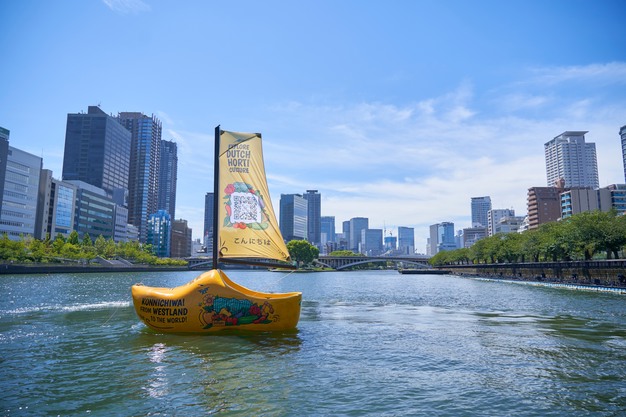After traveling for almost three months by container ship, a large five-meter-long wooden shoe named Cloggy has finally reached Osaka, Japan. It arrived just in time for the World Expo 2025. Sailing along the Osaka River, Cloggy passed by notable landmarks such as the famous Osaka Castle and the Oebashi Bridge near City Hall. Its vibrant colors, eye-catching sail, and unique greenhouse-inspired design immediately attracted the attention of both locals and tourists.
 © Gemeente Westland
© Gemeente Westland
The Municipality of Westland is borrowing Cloggy from the City of The Hague, which originally developed the boat for the Volvo Ocean Race in 2017–2018. Cloggy symbolizes the past, present, and future of Westland’s greenhouses. Decades ago, wooden clogs were everyday footwear in Westland’s greenhouses. Today, this oversized clog showcases the sector’s innovative, forward-thinking spirit.
The sail carries a QR code that links visitors to a short video about Westland’s cutting-edge greenhouse industry. The video highlights how smart technology and sustainable solutions are shaping the future of food production.
 © Gemeente Westland
© Gemeente Westland
The Netherlands shares greenhouse innovations with Japan and the world
After its voyage along the Osaka River, Cloggy has now found a permanent spot on the quay, where visitors can admire it up close. People are snapping plenty of photos with the colorful clog and scanning the QR code on its sail. Through Cloggy, World Expo visitors are discovering the strength and innovative spirit of Westland’s greenhouse sector.
Westland also connects space technology and greenhouse horticulture at World Expo Osaka
What can space exploration teach us about growing better food on Earth? That’s the question NASA researcher Raymond Wheeler will answer during the Controlled Environment Agriculture symposium at the World Expo 2025 in Osaka. The event, taking place on 3 September, is organized by the Netherlands Embassy in Japan, the Municipality of Westland, and Dutch Greenhouse Delta. Wheeler will connect the dots between space technology and Dutch horticultural methods.
The American plant scientist is visiting Japan at the invitation of the Municipality of Westland. For more than 30 years, he worked at NASA tackling a vital question: how do you produce food, oxygen, and clean water in space? His team developed systems to grow crops in fully artificial environments — technologies now widely applied in greenhouses here on Earth.
In his presentation, Wheeler will show how innovations such as LED lighting, vertical farming, and closed-loop cultivation systems were first designed for space missions, yet are now transforming horticulture worldwide. “If you can grow plants hundreds of kilometers above Earth, you can also do it in dry, cold, or other harsh conditions here — and eventually on the Moon and Mars,” Wheeler explains. “Space forces us to make systems smarter and more sustainable. There’s a lot we can learn from that.”
The link between his research and horticulture is clear: both focus on controlled cultivation with minimal use of water, energy, and space. During the symposium, Dutch and Japanese companies and research institutes will exchange ideas on sustainable food production. This dialogue builds on years of collaboration and a shared ambition — working together on smart cultivation solutions for the challenges of today and tomorrow, both on Earth and beyond.
For more information:
Municipality of Westland 
[email protected]
www.gemeentewestland.nl


AloJapan.com